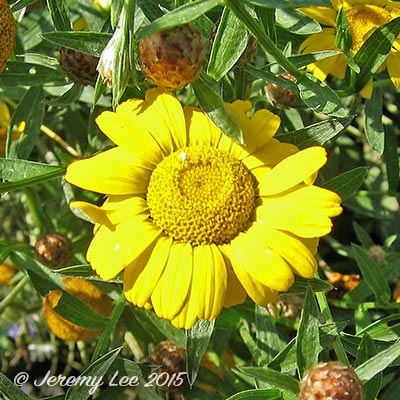
 |
|
Scientific Classifications explained » Amphibians » Ants » Aphids » Bees » Beetles » Birds » Bugs » Butterflies » Caterpillars » Damselflies » Dragonflies » Earwigs » Flies » Frog/Leafhoppers » Fungi » Galls » Grasshoppers » Harvestmen » Hoverflies » Lacewings » Ladybirds » Leaf Mines » Lichens » Mammals » Millipedes » Mosses » Moths » Sawflies » Slugs » Snails » Spiders » Trees & Shrubs » Wasps » Wild Flowers » Woodlice » Postboxes |
UK Nature > Wild Flowers > Yellow Wild Flowers > Glebionis segetum

Scientific Name: Glebionis segetum Common Name: Corn Marigold Glebionis segetum, more commonly known as the Corn Marigold, is a medium height annual and unmistakeable in flower (June to October) with its large bright yellow daisy-like compound flower head. The leaves are slightly fleshy, lobed, hairless and covered with a waxy layer that can give them a greenish blue hue. Until recently this species was know by the old botanical name of Chrysanthemum segetum. Corn marigold was probably introduced into Britain with the introduction of agriculture and has certainly been here since the Iron Age. It can be grown on a range of soils but has a distinct preference for light and moderately acid soils. Most often found as an arable weed it can also be found on other disturbed sites such as rubbish tips, road verges, waste ground and even over-grazed pasture. Locally frequent and widespread in Britain. |
|

https://www.uknature.co.uk is a website dedicated to showing the immense diversity of UK nature and wildlife. Our vast range of habitats, from lowland arable to snow covered mountains, from storm-ravaged coastlines to peaceful inland freshwater lakes and rivers, from dry, sandy heaths to deciduous and coniferous forests, all these habitats contribute to the abundance of UK nature. We have wild birds in huge numbers either residing or visiting our shores (597 recorded species as at July 2013) and we must also not forget the humble back garden with its grass lawns, flower beds filled with nectar rich flowers, shrubs and trees, all designed to attract huge numbers of insects such as bees, moths, butterflies and hoverflies; and finally the small ponds which provide safe havens for frogs, toads, newts and even slow worms and grass snakes. www.uknature.co.uk is the showcase for my personal passion, photographing uknature in all its glory. I sincerely hope you all enjoy the fruits of my labours. This site and all images contained therein is © Jeremy Lee 2004 - 2025. All Rights Reserved. Site design by Jeremy Lee. Site development & IT Support by Stuart Lee. |